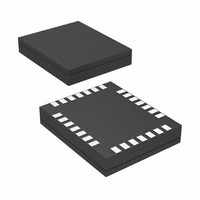USBN9603SLBX National Semiconductor, USBN9603SLBX Datasheet - Page 12

USBN9603SLBX
Manufacturer Part Number
USBN9603SLBX
Description
IC CTRLR FULL SPEED 28-LAMCSP
Manufacturer
National Semiconductor
Datasheet
1.USBN9604-28MNOPB.pdf
(60 pages)
Specifications of USBN9603SLBX
Controller Type
USB 2.0 Controller
Interface
Parallel/Serial
Voltage - Supply
3 V ~ 5.5 V
Current - Supply
30mA
Operating Temperature
0°C ~ 70°C
Mounting Type
Surface Mount
Package / Case
28-Laminate CSP
For Use With
USBN9604-HS-EB - KIT NODE CONTROLLER SAMPLE
Lead Free Status / RoHS Status
Lead free / RoHS Compliant
Other names
USBN9603SLBX
USBN9603SLBX/NOPB
USBN9603SLBXTR
USBN9603SLBX/NOPB
USBN9603SLBXTR
Available stocks
Company
Part Number
Manufacturer
Quantity
Price
www.national.com
2.0 Functional Overview
2.4 ENDPOINT PIPE CONTROLLER (EPC)
The EPC provides the interface for USB function endpoints. An endpoint is the ultimate source or sink of data. An endpoint
pipe facilitates the movement of data between USB and memory, and completes the path between the USB host and the
function endpoint. According to the USB specification, up to 31 such endpoints are supported at any given time. USB allows
a total of 16 unidirectional endpoints for receive and 16 for transmit. As the control endpoint 0 is always bidirectional, the
total number is 31. Seven endpoint pipes with the same function address are supported. See Figure 3 for a schematic dia-
gram of EPC operation.
A USB function is a USB device that is able to transmit and receive information on the bus. A function may have one or more
configurations, each of which defines the interfaces that make up the device. Each interface, in turn, is composed of one or
more endpoints.
Each endpoint is an addressable entity on USB and is required to respond to IN and OUT tokens from the USB host (typically
a PC). IN tokens indicate that the host has requested to receive information from an endpoint, and OUT tokens indicate that
it is about to send information to an endpoint.
On detection of an IN token addressed to an endpoint, the endpoint pipe should respond with a data packet. If the endpoint
pipe is currently stalled, a STALL handshake packet is sent under software control. If the endpoint pipe is enabled but no
data is present, a NAK (Negative Acknowledgment) handshake packet is sent automatically. If the endpoint pipe is isochro-
nous and enabled but no data is present, a bit stuff error followed by an end of packet is sent on the bus.
Similarly, on detection of an OUT token addressed to an endpoint, the endpoint pipe should receive a data packet sent by
the host and load it into the appropriate FIFO. If the endpoint pipe is stalled, a STALL handshake packet is sent. If the end-
point pipe is enabled but no buffer is present for data storage, a NAK handshake packet is sent. If the endpoint is isochro-
nous and enabled but cannot handle the data, no handshake packet is sent.
A disabled endpoint does not respond to IN, OUT, or SETUP tokens.
The EPC maintains separate status and control information for each endpoint pipe.
For IN tokens, the EPC transfers data from the associated FIFO to the host. For OUT tokens, the EPC transfers data in the
opposite direction.
2.5 MICROCONTROLLER INTERFACE
The device can be connected to a CPU or microcontroller via the 8-bit parallel or MICROWIRE interface. The interface type
is selected by the input mode pins MODE0 and MODE1. In addition, a configurable interrupt output is provided. The interrupt
type can be configured to be either open-drain active-low or push-pull active high or low.
USB
USB SIE
Compare
Function
Address
(Continued)
EPZ
EPC.
EP0
Figure 3. EPC Operation
EPY
EPB
EPX
EPA
Transmit Endpoint Pipes
Receive Endpoint Pipes
Control Endpoint Pipe
12
Control Registers
Control Registers
Control Registers
FIFO
FIFO
FIFOs
Microcontroller
Interface
Controller
DMA













